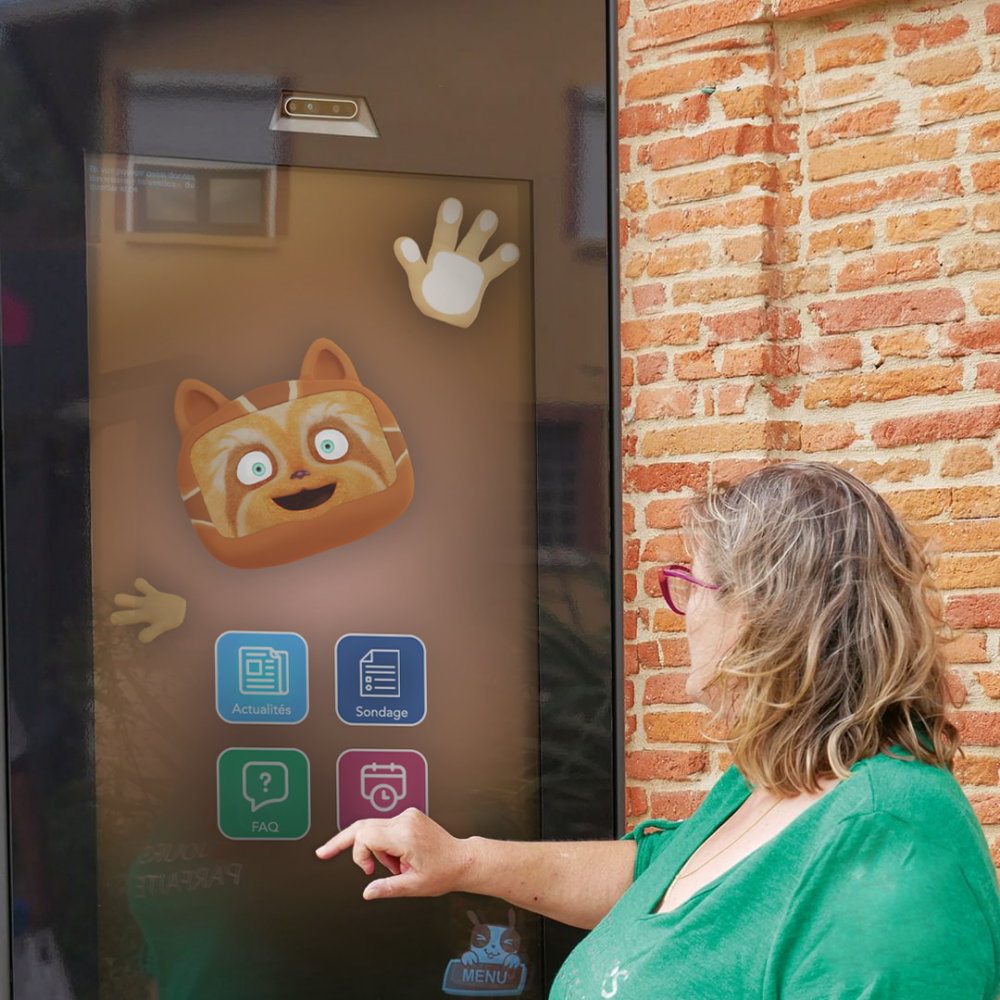Orange has teamed up with the specialists in human-machine interactions at SPooN AI to offer the city council of Saint-Orens en Occitanie an innovative and interactive 5G kiosk. Installed in the city hall forecourt, the kiosk features an interactive digital character named SPooNy. Powered by an artificial intelligence system designed by SPooN AI and the powerful 5G equipment supplied by the Orange 5G Lab in Toulouse, SPooNy answers questions from town residents immediately and in total autonomy. This is the first city council in France to test out a system that has the potential to bring younger residents into the heart of town life.
Published: 22/07/2024

5mn reading time
SPoon AI has tested 5G

Business sector
Robotics and artificial intelligence.

Business needs
– Connection equipment (router and SIM).
– Fully stable and fluid connection to power an artificial intelligence system responding directly to users 24 hours a day, 7 days a week.

Solutions
Interactive and autonomous kiosk in the city hall forecourt (Occitanie).

Benefits of 5G
- Fluid relationships in user-machine interactions,
- Stable connection,
- Completely unrestricted bandwidth (prioritization of flows thanks to slicing*).
Why is there an interactive 5G kiosk in front of city hall?
Initially, the elected officials of Saint-Orens wanted to get younger people to use municipal services. To promote local democracy, the team led by Gautier Lopez (Municipal Head of Local Democracy and Citizen Relations) turned first to multichannel digital communications – “a mobile app, our social media accounts, a survey tool, etc.” – before seeking out a much more original solution. Since 2023, an interactive kiosk installed in the city hall forecourt acts as a front desk assistant to answer questions from residents: bus times, municipal events and calendar, questions about completing forms, etc.
The municipal government called on the expertise of SPooN AI, an Orange partner, which had already created several such kiosks where users interact with a digital avatar. Designed by JC Decaux, the device resembles a giant smartphone that comes to life when users walk up to it, much like a motion detector: the camera recognizes when a human form stops in front of it for several seconds. Users then discover the face of Spoony, a furry and smiling character with big eyes and the appearance of a cartoon red panda. Spoony then asks if the user to give permission for their voice to be captured. If the user agrees, the microphone turns on; if not, it remains switched off, in compliance with the GDPR. The kiosk then captures the user’s voice signals and processes them instantly via the cloud, converting them into text data and sending an immediate response to the avatar. The user can then chat live with a virtual character, by voice, with no further action required on their part. If the user declines to activate the microphone, however, the kiosk will offer to respond through touch screen interaction.
Without the power of 5G, no fluidity, no service
The key to the success of this kind of service is stability. More than a mere matter of bandwidth, it is essential for the connection to remain stable throughout the interaction process. When the user speaks to the character, the kiosk receives the information (visual, audio, textual), anonymizes it and transfers it instantly to the cloud. The voice is transcribed into text code, the content analyzed, the response prepared and returned to the character, who at the same time adapts its emotional gestures. At the slightest interruption in the chain of commands, the Spoony character will freeze, breaking the connection with the user, “and the user will probably never return to the kiosk”, anticipates Luc Truntzler.
Guaranteeing 100% fluidity, and therefore the most natural user experience possible, required the performance of Orange’s 5G network. For this reason, the Orange 5G Lab in Toulouse joined the project, offering to test different types of equipment for connecting to the 5G network.
In addition to its radio performance, the equipment in question had to be able to withstand significant temperature fluctuations and sudden power outages. This collaboration enabled us to test different types of equipment and collectively demonstrate the benefits of 5G”, says Bruno Pouget Innovation and Partnership Business Developer at Orange Campus Toulouse. ” Ultimately, 5G brings the kiosk closer to the cloud and therefore enables AI to deliver its full power. In a way, it’s as if we integrated the internet directly into the kiosk to offer the best quality relationship with the avatar.
He even foresees an evolution of 5G that will guarantee this streamlined relationship and quality thanks to flow prioritization (notably through slicing*).
We can imagine giving bandwidth priority to customers like the Saint-Orens city hall in the event of network congestion”. It’s also a way to guarantee the continuity of public services, which in future will no longer depend solely on opening hours or the availability of staff. “The interactive 5G kiosk gives the public service a modern image”, offering continuous service and full availability with a reassuring and unfailing emotional engagement.
An interactive terminal that promotes inclusiveness
To bring this kiosk to life, SPooN AI designed its character with the utmost finesse, thanks to advanced artificial intelligence. The character can follow the user with its eyes, its pupils dilate if the user gets closer, and it even moves backwards to give the illusion of taking stock. Spoony is also empathetic, responding to a smile with a smile, without undue over-enthusiasm, but with a mirror-like response
This non-verbal communication creates an instinctive connection with the character. As a result, we no longer see the machine, but an animated being. The user feels more relaxed, without the hindrance of thinking they are talking to a kiosk alone, and can therefore express themselves much more freely”, explains Luc Truntzler, Sales Director and Partner at SPooN AI.
Designed as an emotional listening experience rather than a series of actions to be performed on a machine, interacting with the kiosk requires less concentration. It keeps the user from having to think too much. There is no need for keyboards or commands – voice is all it takes. With this natural communication, users of all ages can interact with the city hall’s digital services, thus fostering greater digital inclusion.
A non-humanoid avatar: more endearing, therefore more reliable

The city council of Saint-Orens gets an interactive terminal:
watch the SPooN AI experience in video on youtub (opens in a new window)e
While a cartoon-like robot could easily be used in a store or at a sports event, what credibility does it offer in the context of public services? This question is quickly put at bay by Mr. Lopez, in Saint-Orens:
We need to test things out that can dust off the image of an overly conventional administration. It’s exciting that everything is evolving, and we need to keep up with the trend
At SPooN, we prefer to use cartoon-like characters rather than avatars that imitate humans”, continues Luc Truntlzer, The expert offers two reasons for this, starting with a question of ethics. “We don’t want people to believe that the machine is human. It’s a machine, plain and simple”. The second reason – a strategic one this time – concerns the emotional stakes involved. “Cartoon characters have a higher acceptance rate. You can push the emotional envelope further. You can extend or exaggerate a cartoon’s smile, make its eyes huge, make it jump, and so on. But if you make a human character do somersaults, it’s less believable and even bizarre!” What’s more, the public’s expectations of a kiosk embodied by a humanoid are not the same. “We unconsciously set the bar very high when we think of the other person as human. But we are surprised by the intelligence of a more animal-like avatar. And surprise is a very powerful tool for a service experience.”
However, the kiosk is not intended to replace the human touch. The teams at the city hall are not worried about this and have not noticed any change: “The same people come to see us or call us. The human relationship remains the same for us.”

*FOCUS: “What is slicing?”
Network slicing consists in virtually slicing up a network to respond better to different user needs.
For more information: Network Slicing (orange.fr)

Subscribe to our Orange 5G Lab newsletter
